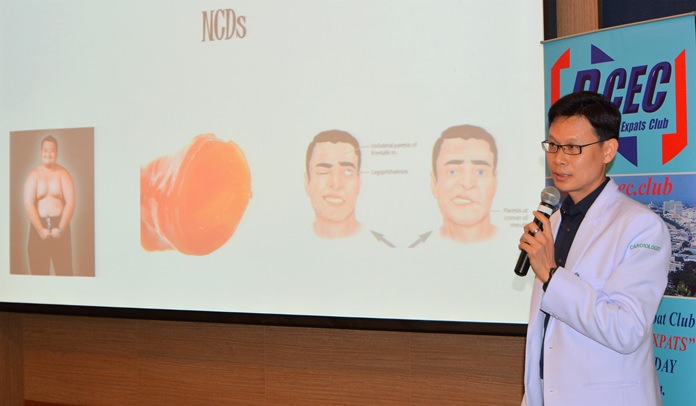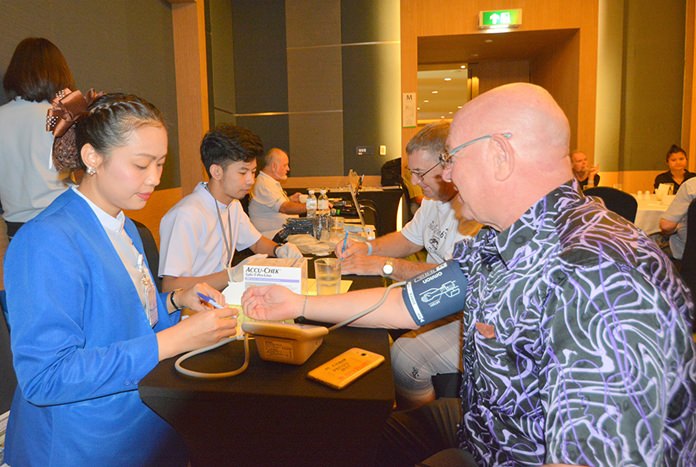
Reduce your risk factors for Non-Communicable Diseases (NCDs) was the message from Dr. Suthep Keeratijareonwong MD from Bangkok Hospital Pattaya’s heart center. These are chronic diseases, not passed from person to person. They are of long duration and generally progress slowly. These diseases often severely affect our well-being as we age. However, many of these diseases can be avoided or limited if we simply observe and correct the negative risk categories as early as possible!

Dr. Suthep Keeratijareonwong is a specialist in Cardiology and is a Medical Interventionist. He noted that his primary duty is handling emergency cases such as heart attack.
Dr. Suthep received his MD from the Faculty of Medicine at the King Chulalongkorn Memorial Hospital, Chulalongkorn University, Bangkok, in 1997. He was an Assistant Medical Director, Srikoraphum Hospital, Thailand, from 1997-2004. He received his Internal Medicine Diploma from the Srinagarind Hospital, Khon Kaen University, Khon Kaen, in 2004; a Cardiology Diploma from the Ramathibodi Hospital, Mahidol University, Bangkok in 2006; and an Interventional Cardiology Diploma from Phramongkutklao Hospital, Phramongkutklao College of Medicine in 2007. He is a Member of the Medical Council of Thailand, the Medical Association of Thailand, the Royal College of Physicians of Thailand, the Heart Association of Thailand, the Thai Society of Cardiac Imaging, and the Cardiovascular Intervention Society of Thailand.
Doctor Suthep first spoke about the causes of NCDs which includes a person’s background, lifestyle and environment. He focused on 6 leading risk factors:
- Foods, including sweets, salt and fat. What we eat and our nutritional status can affect cardiovascular diseases, diabetes and some types of cancer.
- Sedentary lifestyle or a lack of regular physical activity which results in higher levels of risk factors, such as obesity, hypertension or diabetes.
- Stress has long been thought to increase a person’s risk of cardiovascular disease or a serious coronary or cerebral events. There is strong and consistent links between depression, social isolation and lack of quality social support and heart disease.
- Alcohol and cigarette use also have strong links to cancer, cardiovascular disease, liver disease, pancreatitis and diabetes.
- Inadequate sleeping time increases the risk of vascular damage and consequences of stoke, myocardial infarction and overall mortality. All the above causes are avoidable and can be remedied with lifestyle changes.
- This last risk factor is not avoidable – it is genetic caused by errors in genetic information that produce diseases in the affected people. The origin of these genetic errors can be spontaneous errors or mutations to the genome or it may come from inherited genetic errors from parents.
Dr. Suthep then detailed the top 6 most common diseases, within the non-communicable medical category.
First was Abdominal Obesity, which occurs when excessive abdominal fat, around the stomach and abdomen, has built up to the extent that it is likely to have a negative impact on health. There is a strong correlation between abdominal obesity and cardiovascular disease. Abdominal obesity has been linked to Alzheimer’s disease as well as other metabolic diseases. He showed a simple chart that shows the direct correlation between the food we eat and the calories we burn; the calories we don’t burn, turns to fat. Another chart showed the increased percentage of overweight people in the U.S. since the 70’s. From 1976 to 1980, 47% of people age 20-74 years were overweight. By 1988-1994 the number rose to 56% and by 1999-2002 the number was 65%.
Second, was Diabetes, specifically Type 2 Diabetes Mellitus, which is a chronic condition that is largely preventable and manageable but difficult to cure. Management concentrates on keeping blood sugar levels as close to normal as possible. This can usually be with close dietary management, exercise, and use of appropriate medications.
Hypertension (high blood pressure) is third. It is defined as a systolic blood pressure at or above 140 mmHg and/or a diastolic blood pressure at or above 90 mmHg. Systolic blood pressure is the maximum pressure in the arteries when the heart contracts. Diastolic blood pressure is the minimum pressure in the arteries between the heart’s contractions. Hypertension is a risk factor for coronary heart disease and the single most important risk factor for stroke. It stresses your body’s blood vessels, causing them to clog or weaken. Damage to the arteries can also create weak places that rupture easily or thin spots that balloon out the artery wall resulting in an aneurism.
Fourth on the list is Atherosclerosis or hardening of the arteries which is the leading cause of heart attacks, stroke and peripheral vascular disease. The accumulation of the white blood cells is termed “fatty streaks” contain both living, active white blood cells and remnants of dead cells, including cholesterol and triglycerides. The remnants eventually include calcium and other crystallized materials.
Chronic Obstructive Pulmonary Disease (COPD) is fifth. COPD is a type of obstructive lung disease characterized by long-term poor airflow. The main symptoms include shortness of breath and cough with sputum production. COPD is a progressive disease, meaning it typically worsens over time. Tobacco smoking is the most common cause of COPD, with factors such as air pollution and genetics playing a smaller role. In the developing world, one of the common sources of air pollution is poorly vented heating and cooking fires.
Number six on the list is Cancer which is preventable up to 30% by avoiding risk factors including: tobacco, overweight, red meats, artificial sugar and preservatives, fried foods, fungal exposure, raw foods, hydrocarbons, artificial colors and stress.
The bottom-line advice according to Dr. Suthep is, “Correct the risk factors!”
After Dr. Suthep answered many questions from the audience, MC Roy Albiston brought everyone up to date on upcoming events. This was followed by the “Open Forum” portion of the meeting, where questions are asked and answered and comments made about expat living in Thailand.
After them meeting, Ren Lexander interviewed Dr. Suthep about his presentation to the PCEC. To view the video, visit: https://www.youtube.com/watch?v=p_YFDrn8j_A
For more information on the Club and their activities, visit www.pcec.club.




